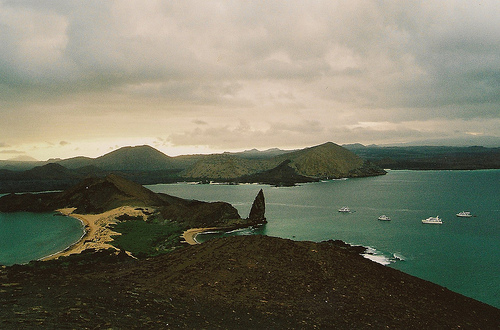The Galápagos Islands are islands full of isolated beauty.
- The Galápagos Islands are a distribution of islands that have been governed by Ecuador since 1832, and were created by volcanic activity, and are located in isolation around the Pacific Ocean’s equator, and are just over 900 kilometres (560 miles) away from Ecuador.
- The ‘Galápagos Islands’ are also known as the ‘Islas Galápagos’, in Spanish, and ‘Archipiélago de Colón’.
- The Galápagos Island archipelago is made up of 18 main islands, 3 small islands and 107 tiny islands or rocks, and is the home to over 25,000 people, spread over five islands.
- The Galápagos Islands became a national park in 1959 and an UNESCO World Heritage Site in 1978.
- The Galápagos Islands were accidentally discovered by Europeans, due to a storm, in 1535, by the Spanish Bishop of Panamá, Fray Tomás de Berlanga, who was on his way to Peru, in South America.
Part of a Galápagos Island
Image courtesy of Charles Zeielinski/Flickr
- The Galápagos Islands have a land mass totalling approximately 8,000 square kilometres (3,089 square miles), with Isabela, the largest island, being 5,827 square kilometres (2,250 square miles) in area, in an ocean area of 45,000 square kilometres (17,000 square miles).
- The first known map of the Galápagos Islands was created in 1570, by the Belgian Gerardus Mercator and Flemish Abraham Ortelius, who were cartographers.
- The Galápagos Islands are accessible by boat and aircraft, with only two airports; one on the island of Baltra, and the other on San Cristobal, and is host to 116 tourism spots, 54 of which are on land, while the rest is devoted to marine activity.
- The Galápagos Islands are home to many endemic species, including 180 plant species, 47 animal species, and 530 marine species, and is also home to numerous other plant and marine species, and some of their most notable animals are the marine iguana, and the Galápagos land iguana, giant tortoise, sea lion and hawk.
- The Galápagos Islands are at constant threat of being damaged by tourism, excessive fishing and introduced species of fauna and flora.
Bibliography:
Galápagos Islands, 2014, UNESCO World Heritage Convention, http://whc.unesco.org/en/list/1
Galápagos Islands, 2014, Wikipedia, http://en.wikipedia.org/wiki/Gal%C3%A1pagos_Islands








